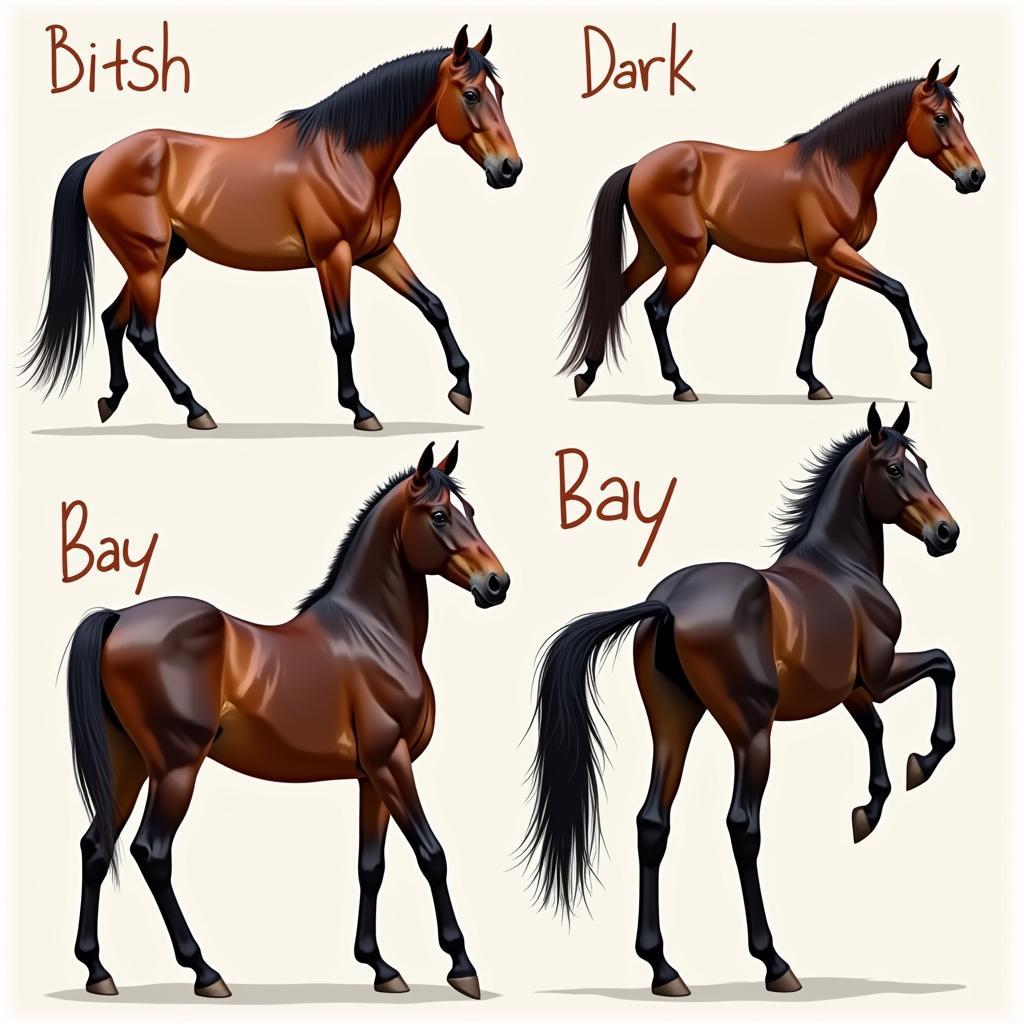The world of horse colors is vast and captivating, often seeming like a secret language to the uninitiated. Among the many stunning shades that grace equine coats, bay holds a special place. It’s a popular choice for its classic beauty, versatility, and the sheer number of variations it encompasses. If you’ve ever found yourself fascinated by the subtle nuances within the bay spectrum, then understanding the Bay Horse Color Chart is your gateway to unlocking a world of equine color genetics.
 Bay Horse Color Variations
Bay Horse Color Variations
What Defines a Bay Horse?
At its core, the bay horse color is characterized by a rich brown body coat that can range from a light reddish-brown to a deep, almost black chocolate. This base color is then accented by specific “points” – the mane, tail, and lower legs – which are always black. This striking contrast is what gives bay horses their distinctive and undeniably elegant look.
Navigating the Bay Horse Color Chart
While the basic definition of bay might seem straightforward, the true beauty of this color lies in its incredible diversity. The bay horse color chart helps us categorize these variations, providing a common language for horse enthusiasts to describe and appreciate the subtle differences in shades and patterns.
Common Bay Horse Colors:
- Light Bay: As the name suggests, light bay horses showcase a coat that leans towards the lighter end of the brown spectrum, often with a warm, reddish hue.
- Blood Bay: This striking variation features a deep, rich brown coat that evokes the color of dried blood, hence the name.
- Dark Bay: Dark bay horses possess a coat that’s so deep and saturated that it can appear almost black in certain lights.
Other Bay Horse Colors and Markings:
- Brown: While often considered a separate color, brown is technically a variation within the bay family. Brown horses lack the black points characteristic of other bay horses, exhibiting a consistent brown color across their entire body.
- Dun: The dun gene introduces a fascinating layer of complexity to the bay horse color chart. Bay duns have a diluted body color, often described as a tan or yellowish-brown, and typically exhibit primitive markings like a dorsal stripe and zebra stripes on their legs.
- Bay Roan: The roan gene causes white hairs to be interspersed throughout the coat, creating a striking roan pattern. Bay roans have a base bay coat color with this roaning effect, resulting in a beautifully blended appearance.
Genetics of the Bay Horse Color
The captivating array of bay horse colors stems from the fascinating world of equine genetics. The bay base color is determined by the interaction of two genes:
- Agouti (A) Gene: This gene controls the distribution of pigment in the horse’s coat.
- Extension (E) Gene: This gene determines whether the horse will produce black or red pigment.
In the case of bay horses, the presence of both the dominant Agouti (A) gene and the dominant Extension (E) gene results in the classic bay coat color with black points. Variations within the bay spectrum are influenced by other modifier genes that can lighten or darken the base coat color, creating the stunning range we see in the bay horse color chart.
The Allure of the Bay Horse
Beyond their genetic makeup, bay horses hold a special place in equestrian history and culture. Their versatility, athleticism, and calm temperament have made them favored partners in various disciplines, from dressage and show jumping to racing and trail riding.
“Bay horses are renowned for their trainability and willingness to work,” says renowned equine veterinarian Dr. Emily Carter. “Their calm and steady demeanor, coupled with their athletic abilities, make them suitable for riders of all levels.”
Conclusion
The bay horse color chart is a testament to the captivating diversity found within a single color family. From the warmth of a light bay to the dramatic richness of a dark bay, each shade tells a story of genetics and heritage. Whether you’re a seasoned equestrian or a casual admirer of these majestic animals, taking the time to understand the nuances of bay horse color can deepen your appreciation for the beauty and complexity of the equine world.
FAQ
1. Are bay horses always born bay?
No, bay foals can be born with a lighter shade, often a reddish-brown, which darkens as they mature and shed their foal coat.
2. Can a bay horse have white markings?
Yes, bay horses can have white markings like any other horse color. These markings are controlled by different genes and do not affect the underlying bay base color.
Need More Help?
Have questions or need personalized advice regarding your horse? Contact us!
Phone Number: 0772127271
Email: [email protected]
Or visit us at: QGM2+WX2, Vị Trung, Vị Thuỷ, Hậu Giang, Việt Nam.
Our dedicated customer care team is available 24/7 to assist you.